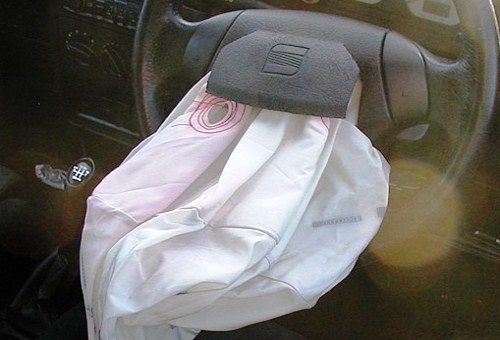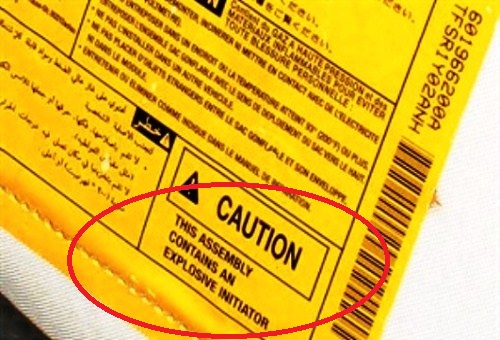
Image source: https://upload.wikimedia.org/wikipedia/commons/2/20/Airbag_SEAT_Ibiza.jpg
In a previous article, we explained how to test the SRS (Supplemental Restraint Systems) on some makes and models without the use of factory scan tools. While these methods are valid and applicable to the makes and models described in the article, deactivating and then reactivating airbags after some types of service procedures on several makes and models is something else entirely. In fact, the chances of inadvertently deploying one or more airbags on some vehicles is somewhat akin to walking on a tight rope, and the slightest mistake can set off airbags, which could lead to serious personal injury to yourself and/or thousands of dollars of damage to the vehicle, which your employer is bound to view unfavourably. Thus, in this article, we will take a closer look at how to avoid such mishaps with special reference to vehicles whose airbags are known to be temperamental, but let us start with some-
While airbags have saved thousands of lives since they were first introduced, these devices have also caused thousands of injuries, ranging from fractured skulls and serious chest injuries, todecapitations, to broken arms and legs, and even to cardiac issuesthat can manifest days or weeks after an airbag deployment.
Of course, we are talking here of injuries caused by airbag deployments during crashes, and while there are no reliable statistics available on how many technicians have been injured by accidental airbag deployments, the fact is that many technicians the world over have suffered serious facial, cranial, and musculoskeletal injuries as the result of accidental airbag deployments. As a matter of interest, airbags typically deploy in considerably less than one-tenth of a second, and at speeds of about 320km/hour.
In terms of risk exposure, AC technicians are most at risk, since their work routinely brings them closer to airbags in steering wheels and dashboards. However, any technician is at risk when performing work that requires the deactivation, and subsequent reactivation of airbags. In many cases though, the risk is not as the result of sloppy or incorrect service procedures; we all know of the defective Takata airbags that are fitted to more than 14 million vehicles worldwide, and that these airbags can deploy “without explanation”, as the authors of one study put it.
In the Australian context, four million vehicles with faulty airbags are currently on the road. Although the Federal Government has issued a compulsory recall of what amounts to two out of every seven vehicles on Australia’s roads, there is still a good chance that when you next reconnect the battery on a vehicle, its faulty Takata-made airbags might deploy spontaneously. With some luck, you won’t be injured, but the gases, dust, and metal fragments produced by the deployment will very likely cause irreparable damage to the vehicle’s interior.
Having said the above, we hope that you will be inspired to take extra special care when next you work on airbags, and especially on the airbags in the vehicles listed below. Note though that there is no single airbag deactivation procedure that applies to all applications; all vehicle manufacturers have developed dedicated deactivation procedures that must be followed exactly if accidental airbag deployments are to be avoided, so let us start with procedures for -
Although airbag deactivation procedures have been somewhat simplified for models after the 2008 production year, 2008 models are particularly susceptible to accidental airbag deployments. For instance, any sort of test light, circuit tester, multimeter, or other powered testing device can set off one or more airbags on the worst affected Mazda 5 models.
The only way to diagnose the airbag control module on these models for faults, defects, or malfunctions is to use the on-board diagnostic function, but note the following-
Note that it is necessary to deactivate the airbags to perform any diagnostic, maintenance, or servicing procedures on the steering wheel, steering column, seat belt tensioners, instrument cluster, impact sensors, or airbags.
Note the following steps/procedure, which is the only way to disable the airbags on affected models safely-
Note that failure to observe the above steps will almost certainly result in accidental airbag deployment(s). In addition, be aware that some diagnostic and/or servicing procedures require the use of up-to-date service information and software, as well as suitable diagnostic equipment and model-specific SRS load tools and their associated jumper cables and adapters.
WARNING: It should be noted that since the airbags on this model are particularly temperamental, great care must be taken during diagnostic and servicing procedures on the SRS system to avoid inadvertently deploying one or more airbags. In fact, more accidental airbag deployments occur on this specific Audi model than on all other VAG group vehicles combined. Therefore, observe the following procedures when working on the SRS system of this Audi model-
1) Never use test lights, circuit testers, multimeters, or any other powered test devices to diagnose faults, defects, or malfunctions in any part of the SRS system
2) Pyrotechnic devices and control modules in the SRS system may only be installed, programmed, diagnosed, and tested using VW’s approved vehicle diagnostic and information systems
3) Before working on the airbag control module (module J234) or on pyrotechnic devices, the NEGATIVE battery cable must be disconnected while the ignition switch is in the “ON” position. Insulate the negative battery terminal with insulation tape to prevent contract with the bodywork, but DO NOT switch off the ignition
4) After disconnecting the NEGATIVE battery cable, wait at least 10 seconds to allow ALL capacitors in the SRS system to discharge before performing ANY diagnostic test on ANY part of the SRS system
5) At this point, it should be safe to perform required diagnostic tests and repairs, but note that it is especially important to discharge all static electricity from your body before touching and/or handling any installed pyrotechnic devices. As a general rule, merely touching a well-grounded part of the bodywork should suffice to discharge static electricity from your body, but note that failure to discharge completely could set off an airbag inflator the moment you touch it
6) When you have completed all repairs (without mishap) you have to reconnect the battery while the ignition switch is in the “ON” position, but before you do, make sure that there is nobody in the vehicle as a safety precaution
However, in some cases it can (and sometimes does) happen that the ignition circuits do not become active when you reconnect the battery. If this happens, DO NOT switch the ignition “OFF” and then “ON” again; in fact, the safest thing you can do in such an event is to keep away from the steering wheel, seat belts, and locations where airbags are installed, because one or more airbags could deploy unexpectedly
In some cases, disconnecting and reconnecting the battery negative cable will resolve the issue, but this is not guaranteed. Therefore, obtaining and consulting reliable service information is now your safest option, since the resolution of the issue depends largely on the kind of work you did and therefore, doing the wrong thing now will almost certainly deploy one or more airbags, which brings us to-

Image source: https://images.autoserviceprofessional.com/post/M-AB03-1.jpg
Note the warning label on this airbag; while the actual wording of these warnings is not always the same between manufacturers or models, these are not idle warnings. At the risk of being overly dramatic, it must be stated that an airbag inflator that explodes in your hands will not only spoil your day- it might very well end your career as a technician.
Nonetheless, let’s look at some things to keep in mind when carrying, handling, or installing airbags, starting with remembering that-
You need to know what you are doing
While it is true that any reasonably skilled technician will be able to diagnose many, if not all SRS system issues, and often without factory-level scan tools, actually handling un-deployed airbags safely requires skills and knowledge that are best obtained by attending and completing formal training courses.
Knowledge of electrical circuits is not enough; what is required is a), expert-level knowledge of the specific circuits that control the SRS system, and b), how these circuits are integrated into the CAN bus system, which integration paths may include control modules and sensors that may not necessarily be related to the SRS system. It should be understood that SRS systems are notoriously fault-intolerant, which as a practical matter, translates into the fact that if you don’t know how SRS systems work, you should not be working on them.
Airbags are dangerous
If you are carrying or handling an un-deployed airbag prior to installation, be sure to keep the deployment surface pointing away from not only your own body, but also away from other persons. In addition, if you have to put the airbag down for some reason prior to installation, place it on the floor or table with the deployment surface facing upwards. If placed with the deployment surface facing down, it will act like a rocket should it deploy, with obvious, and serious safety implications for other people in the workshop when it comes down, or flies off in a sideways direction.
Consider all airbags as dangerous as loaded guns
Remember that even if you have removed system power and allowed recommended discharge times, it is still possible for an un-deployed airbag to deploy if you have built up large static electricity charges in your clothing. We have mentioned this before, but it bears repeating- remember to discharge static electricity from your body and clothing before touching or handling un-deployed airbags. Failure to do this could be the same as dropping a gun that you thought was not loaded; the gun may discharge or it may not, but do you really want to take a chance on it not discharging?
Always wear protective clothing
While airbags might save the lives of vehicle occupants during a crash, almost all crash survivors often sustain some injuries as a result of the airbags having deployed. Common injuries include burns, scalds, and abrasions against hot airbag surfaces, some (temporary) hearing loss, eye injuries from dust and hot gases, and especially serious eye and facial injuries in occupants who had been wearing spectacles.
In light of the above, you would do well always to wear eye protection, some form of hearing protection, as well as long sleeved-clothing that limits your skin’s exposure to the hot surface of an accidentally deployed airbag.
Always inspect all SRS components
While not all defective SRS system components will always set fault codes, airbags depend on all components such as seat belts, seat belt retractors, seatbelt buckles, seatbelt mountings and attachment points to be in perfect working order to work when needed.
Therefore, it is rather pointless to replace airbags for whatever reason when other components are torn, broken, cut, frayed, or otherwise defective. Note though that since SRS systems are critical life-and-limb components, defective or suspect SRS components should only be replaced with new OEM equipment to ensure reliable operation of the airbags when they are needed to work.
While airbag and general SRS system diagnostics have been described as veritable minefields that are ready to blow unwary technicians to bits without any advance warning, the fact is that this largely only applies to technicians and mechanics that follow improper, and in many cases, unauthorised, diagnostic and repair procedures.
Of course, this is not the same as saying that you should underestimate the complexities of modern SRS systems. However, if you are armed with a solid working knowledge of electrical theory, up-to-date service information that is available online, albeit at the price of a subscription or membership of websites such mechanic.com.au, and suitable diagnostic equipment, there is no reason why you would set off airbags accidentally.